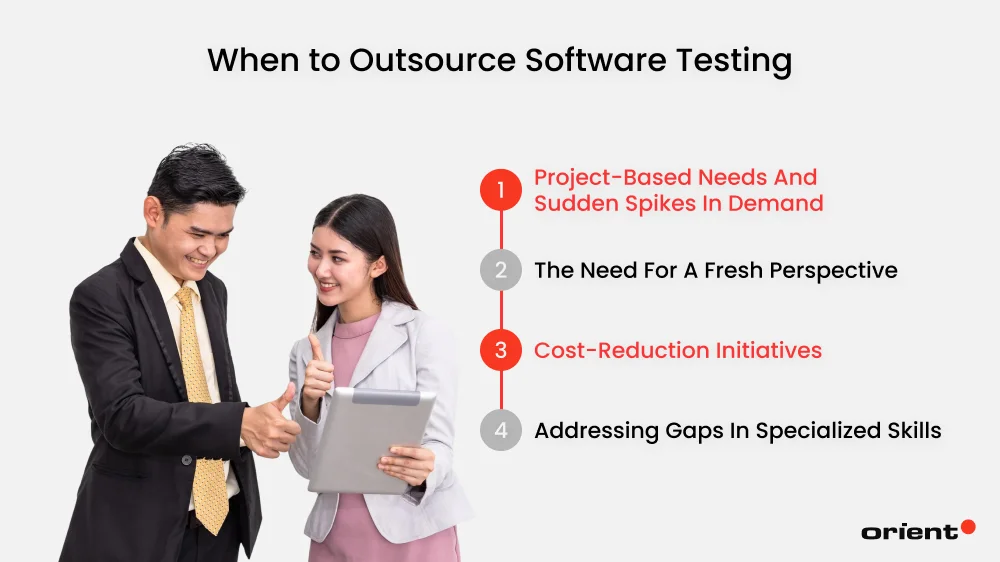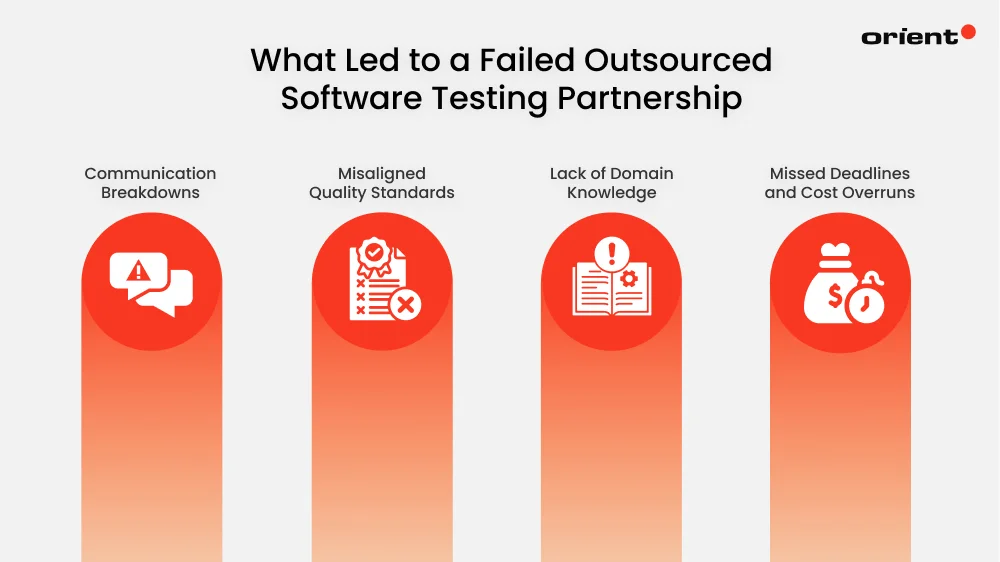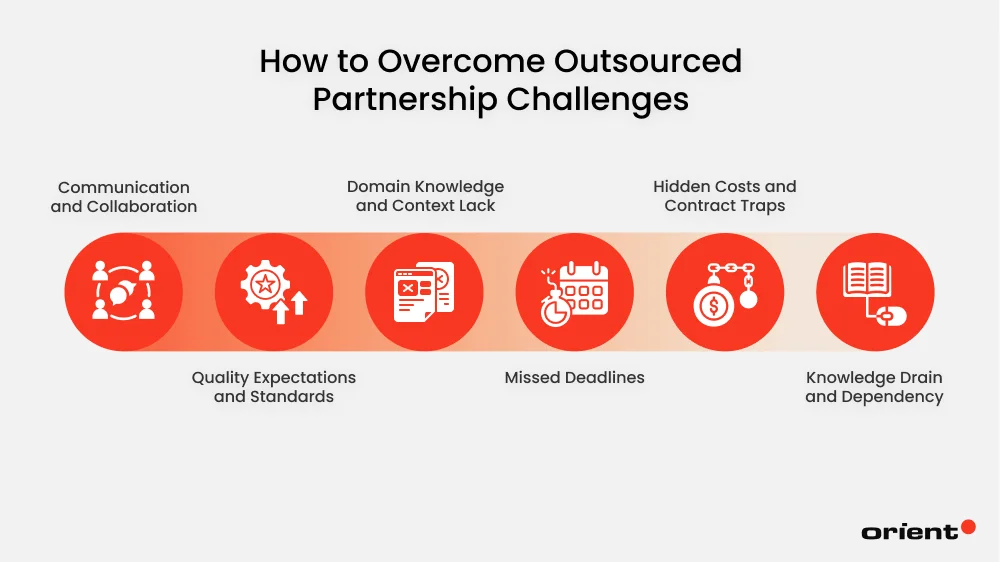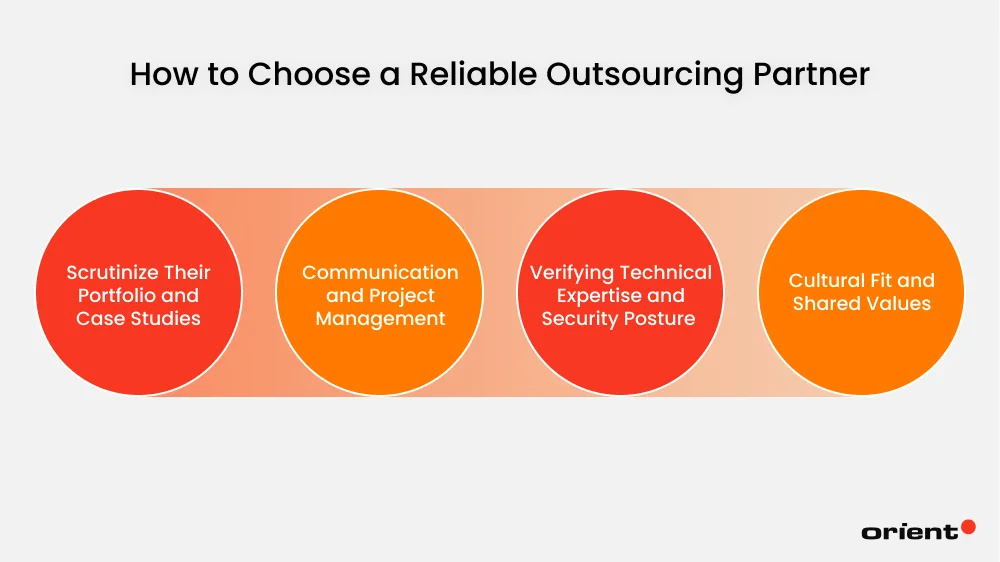The world of outsourced software testing services is perceived as a tactic of achieving efficiency, expertise in particular areas of skills, and affordability. The attractiveness is evident: outsource the most significant process of quality assurance to professional experts and release the internal resources. However, the fact of the matter is that not all partnerships work out. Some reports in the industry show that up to 25%-50% of IT outsourcing ventures fail to deliver or are even terminated altogether. The economic consequences of these failures are so enormous that in the U.S. alone, the cost of bad software quality has been estimated to be more than 2 trillion dollars a year.
These statistics underscore a critical truth: a failed outsourcing partnership is more than a simple business setback. It may cause disastrous project schedules, cost increases, and serious image loss. Although the story is usually built around the faults of one partner, the best that can be learned is that they have shared responsibilities, and it is that behavior on both ends that went wrong. Here, we explore the most popular traps of the dysfunctional outsourced software testing relationships to determine the underlying reasons behind the failures and, above all, learn the lessons that have been learned with blood, which can assist in steering your new project towards a thunderous success.
What Is Outsourced Software Testing?

Fundamentally, software testing is the act of reviewing a product to ensure that it functions as desired by testing features, performance, usability, and security before it gets to final users. A comprehensive testing process assists in finding bugs, enhancing software quality, and making sure that web and mobile applications can be used by various operating systems and on various devices.
Once the companies decide to outsource the software testing, they delegate this task to an outside team or a software testing company. Businesses do not need to form and maintain an in-house QA team but instead use companies that specialize in outsourcing services, which fall into the category of skilled QA engineers, testing tools, and well-developed methodologies. This practice is commonly referred to as software testing outsourcing/QA outsourcing.
The contrast between in-house testing is in the ownership and resources. An internal group is familiar with the product and will be in close contact with the development team, though it may be expensive to recruit and train, particularly when the skills, such as test automation, performance testing, or security testing, are more advanced. On the other hand, outsourced testing offers scalability, new insights, and access to a wider range of expertise, but it needs effective communication and clear expectations to work.
When It’s Time to Consider Outsourced Software Testing
Choosing to outsource isn’t simply a matter of saving money. The strongest reasons usually come from real business needs that a company can’t fully handle on its own.

Project-Based Needs and Sudden Spikes in Demand
For example, your company is going to release a big new mobile application within three months. Your in-house testing team is already stretched out with another project, but to be sure that the new app will be bug-free on its launch, you will have to conduct performance, security, and usability tests simultaneously. This presents a perfect argument for outsourcing. Rather than frantically recruiting, training, and bringing on full-time workers who may just be required to work a few months biannually, businesses can easily expand an outsourced department to work on increased workloads.
A team comes with having testers on board, which means that by recruiting an external company of quality assurance, you gain 5-10 quality assurance testers that would immediately be integrated into the project, and you would meet your deadline without the obligation that hiring demands.
The Need for a Fresh Perspective
In situations where a team is too long on the same product, it ends up ignoring the arising problems merely because it has become too conversant with the product. They are subject to running tests in a similar environment, referring to standard sample data, and on similar hardware or operating systems. This may cause issues such as the smooth operation of an application on the computer of a developer, but the failure when an individual tries to install the application on specific devices.
These think tanks are what an outsourced team can avoid because they look at the product the way brand-new people look at it. They do experimentation on a broad variety of devices and network conditions and even experiment with activities that are not in their intended operations. Consequently, they identify problems that would daunt a select few, although they may tremendously affect the experience of the user (and reputation of the product in the market upon its release).
Cost-Reduction Initiatives
In business, in-house QA testing staffing costs include salaries, insurance expenses, benefits, and office expenses, which are fixed costs because they need to be paid at a regular frequency regardless of the workload. Costs of outsourcing, in its turn, are variable: they are only incurred in case of a project and are directly dependent upon the volume of work. With the conversion of fixed costs to variable costs, organizations can avoid expenditures when they are not in need of those services and channel much of the funds to other important activities.
Addressing Gaps in Specialized Skills
It is not often feasible to assemble a full-time staff that embodies all the fields of expertise in testing. It can take months to recruit experts and require high salaries and benefits, and usually only gets you capabilities that you may require a few times a year. Outsourcing provides the solution to this dilemma because it allows you immediate access to the proven-skilled experts. Large-scale load tests can be rapidly carried out, bottlenecks can be exposed, and your product may be exposed to real-world traffic without the constant cost and commitment of permanent hires.
Why Companies Outsource Testing
Rather than diverting your internal teams to spend valuable time chasing bugs, you can rely on a dedicated team of testing specialists. This strategy guarantees a comprehensive quality of the software and lets your developers do what they do best: building and innovating.

Access to Specialized Expertise
When you work with an outsourced team, you gain access to a wealth of specialized expertise. These teams usually have some very adept specialists at advanced testing techniques, such as carrying out large performance tests using tools like JMeter or LoadRunner, conducting thorough penetration testing to enhance security, and developing automation frameworks that expedite your release cycles. They offer a wider view of things beyond merely technical skills since they have worked on an array of products in varying industries. This enables them to recognize possible risks and usability concerns early on by applying the lessons acquired in other projects that an internal team may not possess.
Scalability and Flexibility
Rather than maintaining a stable of testers in-house who may be overwhelmed by surprise product launches, seasonal traffic spikes, or emergency feature requests, you can instantly supplement your ranks with experienced testers when the pressure cooker heats up. This flexibility also means you’re not stuck with the cost of full-time people that are not needed once a peak time has passed; you only pay for the capacity you need
Focus on Core Business Functions
When you have an external team of dedicated people to do testing, the development process can proceed at the same time, and this will greatly speed up your time to market. This parallel workflow is what gives companies a critical edge in today’s fast-paced, competitive landscape.
While the attraction of outsourced software testing is undeniable, there are many potential missteps on the journey. Let’s de-code those failures and extract the valuable insights.
What Led to a Failed Outsourced Software Testing Partnership?
A failed outsourcing partnership is rarely the result of a single mistake. More often it is a combination of interrelated issues that slowly sap trust and efficiency that result in failed projects. Below are the primary causes of a relationship’s death.

Communication Breakdowns
When an outsourced software testing partnership fails, communication may seem to be the issue on the surface. However, underneath are deeper, more complex issues that drive the breakdown: a collision of communication cultures and an underlying mismatch of priorities.
The difference in communication culture is a subtle barrier that can easily be overlooked. As an example, your internal team may be a direct and low-context culture, where feedback such as “This is a bug, and it needs to be fixed immediately!” is regarded as normal and efficient.
In contrast, the outsourcing partner may come from a high context culture, which believes in harmony, and a phrase like “Perhaps we should re-examine this point” is their way of saying, “There is a major flaw here that requires urgent attention”. This cultural gap leads to a dangerous misunderstanding: you feel like they’re not in a hurry, and they may feel that you’re being disrespectful by being so direct. Without a common understanding of these nuances in communication, trust is eroded and collaboration strained.
Misaligned Quality Standards
Quality misalignment is often not an issue of carelessness. It is usually a case of both parties having different and unstated understandings of what ‘quality’ really is. You may be thinking that quality means getting a product that meets all its technical specifications and requirements, and that it passes all test cases. Your partner may be thinking that quality means delivering a product that users can interact with seamlessly and that runs consistently, day in and day out, out in the real world. The result is a product that is technically “correct” but falls short in terms of actual user experience.
The difference isn’t about who understands the product better; rather, it’s about the kind of context each side brings. An in-house team lives with the product day to day: they’ve heard customer complaints directly, know which small tweaks might frustrate VIP users, and understand the quirky, illogical ways people actually interact with the system. Outsourced teams, meanwhile, often carry a broader perspective. Having worked across different industries and platforms, they recognize patterns, best practices, and pitfalls that internal teams might overlook. Neither view is complete on its own; the richest insight comes when the product-specific knowledge of the internal team meets the cross-industry experience of an outsourced partner.
Lack of Domain Knowledge
A lack of domain knowledge is more dangerous than missing a few bugs; it skews the very definition of success. It’s not a question of technical skill; rather, it’s about lacking the business context that gives each feature its real meaning.
An outsourced team might proudly report a 100% pass rate, declaring the product “bug-free,” while overlooking a flow that drives customers to abandon the app. The testing was flawless against the checklist, but the checklist itself was never aligned with what truly matters.
The lack of awareness can silently convert minor problems into failures that have a devastating impact on the business. As a simple case illustration, users who use banking services embrace three levels of authentication to secure their banking services, but in e-commerce, the same three steps would result in abandoned carts. Without an intuitive understanding of such industry-specificities, an outsourced team will confirm the functionality of the software but fail to understand facts that define whether it will be successful in the market.
Missed Deadlines and Cost Overruns
Delays and overcost are the synthesized product of minor cracks that grow in the dark. The problem is usually caused by two invisible debts:
- Technical debt: techniques of shortcuts to meet deadlines, which result in code that is so fragile that it increases the maintenance cost of the code in the future.
- Knowledge debt: where inadequate knowledge transfer requires the outsourced team to recreate undocumented systems, it takes valuable time.
Although tasks may seem complete on their own, the integration process exposes some element of dependency, such as out-of-date APIs or incompatible environments, which are dragging the project into integration hell. This is where time zone differences and culture gaps aggravate. An incorrectly understood requirement can take days to clarify over asynchronous communication.
These little misalignments not only slow down the delivery, but compounded in the cost of rework and billable hours as well as costly urgent fixes.
Overcome Outsourced Partnership Challenges
The key to managing an outsourced partnership is to quickly tackle the issues that may cause severe problems. The most common fears of communication, quality and project control can be dealt with using the appropriate strategies.

- Communication and Collaboration: The major cause of friction in outsourcing collaborations is communication breakdowns. To reduce it, develop a structured communication plan in the beginning. Indicate the tools, including Slack (real-time chat), Jira (issue tracking), and Trello (project management). The frequency of the meetings (daily stand-ups and weekly status reports) and the party that will be responsible for each channel. Further, appoint one point of contact on each side of the river, a specific project manager or a liaison, who will be the main point of contact and ensure that messages are not lost in translation or channeled the wrong way.
- Quality Expectations and Standards: Another common myth is that the outsourced team would automatically know and implement your internal quality metrics. To solve this, all quality standards should be clearly defined and documented prior to the commencement of testing. Include reasonable bug-to-feature ratios, establish levels of bug severity, and describe acceptance reasons for each user story. Unify all test cases and outcomes through a common quality management platform, like TestRail or Zephyr, to serve as a source of quality information shared by both teams. This makes the two teams strive towards the same and quantifiable definition of what is done.
- Domain Knowledge and Context Lack: In order to fill this gap in knowledge, businesses need to invest in a rigorous process of knowledge transfer. This may involve special training courses, live product demonstrations, and direct access to internal subject-matter specialists. One way to achieve that is to organize deep-dive workshops by the in-house team, where all the core functionality and business logic of the product will be discussed. In this way, the testing team will be aware of what they are testing, as well as the purpose of testing. This better insight would assist them in identifying elaborate edge instances and non-intuitive bugs that would be missed by a shallow examination.
- Missed Deadlines: It is normally the result of the absence of transparency and an out-of-sight, out-of-mind attitude. Instead of weekly email updates, successful partnerships have a common project dashboard. The dashboard also gives real-time access to the activities, the state of test execution, and the success rate of bug resolutions. This will allow both parties to identify possible delays when they occur and not retrospectively. Also, scope creep can be avoided by using an agile approach to project implementation and having well-defined sprints and frequent retrospective meetings.
- Hidden Costs and Contract Traps: Outsourcing is commonly assumed to incur hidden costs is not unfounded such as scope creep, overtime, or post-launch fixes can inflate budgets. The difference lies in structure. Clear service-level agreements, transparent pricing, and shorter contract cycles turn what seems like a financial risk into cost predictability. Companies that negotiate flexibility at the outset often discover that outsourcing reduces surprises compared to in-house overruns.
- Knowledge Drain and Dependency: Perhaps the deepest concern is that outsourcing drains product knowledge from internal teams. But this is changing. Many vendors now adopt co-creation models, embedding QA engineers alongside developers, sharing test documentation, and running joint retrospectives. Instead of hollowing out expertise, outsourcing expands it, leaving both sides with stronger collective knowledge.
How to Choose a Reliable Partner
So far, you’ve seen the potential of outsourced software testing. You understand the immense value it can bring but you’ve also heard the cautionary tales from the “What Led to a Failed Partnership?” section. The gap between a successful partnership and a failed one is bridged by one critical decision: choosing the right partner.
This isn’t just about hiring a vendor, it’s about forging a strategic alliance. Let’s explore how to identify a partner that won’t just find bugs, but will actively elevate your product.

Scrutinize Their Portfolio and Case Studies
Any established software testing company can present a list of past clients. Your job is to look past the logos and find the story behind them. Imagine you’re a fintech startup; a partner whose portfolio is filled with gaming apps may not grasp the mission-critical need for security testing in your industry. Seek out a provider whose history resonates with your own challenges. Look for previous projects that mirror your application’s complexity, whether it’s handling high-volume transactions for web and mobile applications or ensuring compliance in the healthcare space.
A true partner doesn’t just talk about their testing process, they demonstrate its impact with hard data. Instead of vague promises, look for case studies with concrete metrics like, “We reduced critical bug leakage by 95% for a leading SaaS platform” or “Our test automation strategy cut their release cycle by 40%.” This is the proof that their comprehensive software testing delivers real business value, not just a bug report.
Communication and Project Management
Think of communication as the central nervous system of your project; a breakdown here can paralyze your entire software development process. A reliable partner demonstrates this through action, not just words. They don’t just “use Agile”, they become active participants in your daily stand-ups and sprint planning, offering insights that prevent problems down the line.
This transparency must be tangible. Look for a team whose testing process is visible and clear within tools like Jira. Their bug reports should be immediately actionable for your development team, complete with clear steps, logs, and video recordings. This entire workflow is often managed by a dedicated lead QA engineer, who acts as your strategic point of contact, not just a messenger, but a partner who translates testing data into insights that protect your product’s quality and your business goals.
Verifying Technical Expertise and Security Posture
Nowadays, in the time of unceasing cyber threats, credential verification is required. Your code, as well as potentially sensitive data, will be available to your partner.
So, seek the indisputable evidence of their interest in quality and security. This is not merely saying that they conduct security testing. Request some certifications, such as the ISO 27001, which is the international standard on information security management. Such an assurance indicates that they have strong data encryption processes and that they have tight controls over access. Equally, the fact that their respective test engineers are qualified, e.g., ISTQB certifications, reflects an in-depth and standardized understanding of testing practices. Their professionalism should also be seen through their ability to use the current testing instruments so that they can use the appropriate technology on your stack of stacks to do both the manual testing and the advanced type of automation.
Cultural Fit and Shared Values
The partnership is not merely a checklist and certification, but it is people with a similar working mindset. A conflict in values cannot be resolved through processes, and therefore cultural alignment cannot be optional but rather mandatory.
To assess this, don’t just review slide decks; observe how the partner behaves in practice:
- Run a pilot project or workshop: Watch how they respond to last-minute changes. Do they collaborate on solutions or just push responsibility back?
- Check communication style: Set up regular syncs and see if they’re transparent about challenges instead of sugarcoating reports.
- Test for ownership: Ask them to challenge one of your assumptions during onboarding. A good partner isn’t afraid to question you if it leads to a better product.
- Gauge decision-making under pressure: In a simulated crisis, do they freeze, follow the contract literally, or step up to protect your business goals?
You’re not just outsourcing tasks, you’re entrusting a piece of your brand’s reputation. The right partner treats that responsibility as their own, aligning their behavior and decisions with your company’s values in the moments that matter most.
Orient Software: The Right Partner That You Need
Orient Software is aware of the traps you have witnessed: communication failures, inappropriate quality benchmarks, and others. That is the reason we constructed our methodology in such a way that it would not happen. We pay attention to effective communication, strict quality standards, and customer-centeredness. We would like to ensure that your software testing partnership is a resource of strength rather than a cause of concern.
Are you ready to take a step with a trustworthy partner? Ensure your future business succeeds on the initial day. Contact Orient Software today to talk over your project requirements and learn how our professional staff can provide you with quality, dependable software testing services at the right price.














